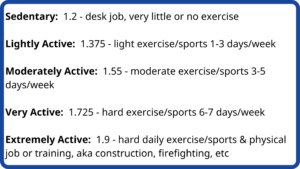In this article we’re gonna explain what the BMR formula is and give you a couple of really good options so that you can calculate your basal metabolic rate for weight loss.
After checking out both of these formulas, you can decide which one will be the best BMR formula for you.
Let’s dive in!
 The Katch McArdle BMR Formula
The Katch McArdle BMR Formula
The first BMR formula we’re gonna take a look at is called to Katch McArdle formula. This formula is widely used to calculate your BMR and then your total daily energy expenditure.
Here’s what the formula looks like:
BMR = 370 + [21.6 X LBM (kg)]
Body Weight (kg) = Body Weight (lbs) / 2.2
LBM = Lean Body Mass (kg)
Lean Body Mass step 1: % Body Fat X Total Body Weight (kg) – weight of fat on your body (fat weight)
Lean Body Mass step 2: Total Body Weight (kg) – (fat weight) = LBM
Here’s an example:
If you weigh 185 lbs and have 14% body fat…
Body Weight (kg): 185/2.2 = 84kg
LBM: .14 X 84 = 12 kg of fat = fat weight
LBM: 84 kg – 12kg = 72 kg LBM
BMR: 370 + (21.6 X 72) = 1925 cals
The Katch McArdle formula is a little bit more advanced. In order to use this one, you’ll need to know your percent body fat and lean body mass. If you know your percent body fat, you can calculate your lean body mass.
Here’s an example of how to calculate your lean body mass if you know your percent body fat:
LBM = Lean Body Mass (kg)
Lean Body Mass step1: % Body Fat X Total Body Weight (kg) – this gives you weight of fat on your body (fat weight)
Lean Body Mass step 2: Total Body Weight (kg) – (fat weight) = LBM
The Katch McCardle formula is one of the more precise form formulas for calculating your BMR. There are a couple ways to get your percent body fat. First, you can buy a skin fold tester and test yourself. You can pick one up from Amazon or many other places are at a pretty reasonable price. Alternatively, you can go to any local gym and talk to them. Most gyms will have one of their trainers test your percent body fat at no charge.
Also, this BMR formula is best suited for individuals who are in pretty decent shape with a know percent body fat.
The Modified Harris-Benedict Formula
Another widely used BMR formula is the harris-benedict formula. There are actually two different formulas. There’s a version for males, and a version for females. Mini people who are neuer two body transformations elect to use this formula over the couch McArdle formula. It’s a little simpler and easier to use. Also, you don’t need to know your percent body fat in order to calculate your BMR.
Here are both the male and female Harris-Benedict Formula variations:
Male: (88.4 + 13.4 x weight) + (4.8 x height) – (5.68 x age)
Female: (447.6 + 9.25 x weight) + (3.10 x height) – (4.33 x age)
Note: This formulas uses metric measurements: weight in kilograms, height in centimeters, age in years so be sure to convert your height and weight to metric units. (2.2lbs per kg, and 2.54cm per inch)
Here’s an example for you:
This is for a male who is 225 lbs, 5’10” (70″) and 40 yrs old
Weight (kg): 225/2.2 = 102kg
Height (cm): 70 x 2.54 = 178cm
BMR: 88.4 + (13.4 x 102) +(4.8 x 178) – (5.68 x 40)
BMR: 88.4 + 1367 + 854 – 227 = 2082 cals
Total Daily Energy Expenditure (TDEE)
Now that we know our BMR using either the Katch McArdle or the Harris-Benedict equation, we can calculate our Total Daily Energy Expenditure. The TDEE factors in your exercise and NEAT calories burned throughout the day. (NEAT – Non-Exercise Activity Thermogenesis). The TDEE is simply how many calories you should eat to maintain your current weight.
Don’t worry. This equation is really easy math!
TDEE = BMR x (activity factor)
Here are the activity factors:

Let’s take a look at our 5’10”, 40-year old male weighing in at 225lbs:
BMR: 2082 cals
Activity Level: Lightly Active – 1.375
TDEE: 2082 x 1.375 = 2,863 cals
How To Use These Formulas To Burn Fat
OK, so how many calories should you eat to lose weight then?
In order to lose weight and burn body fat, we need to create a caloric deficit. It’s really that simple. We just need to eat fewer calories per day than the TDEE.
How much of a deficit do we create then?
It is always healthy and better for long-term weight loss to take things gradually. A pound of fat is approximately 3500 cal. If we plan on losing 1 pound of fat per week, then we would simply need to create of 500 calorie deficit per day for seven days of the week. If you want to lose 2 pounds per wee then you need a 1000 cal per day deficit. It’s important to note that this deficit can come from a combination of exercise and cutting calories from the diet.
To stay healthy and maintain lean muscle mass, it’s not recommended to go more aggressive than 2 pounds per week.
There are two reasons for this.
First, you risk losing lean body mass. And second, when you are in a prolonged calorie deficit, your metabolism start to slow down. This actually makes it easier to regain all the fat you lost. That’s why so many fad diet’s fail. They aggressively cut calories to see the short term gains only to return to their starting weight or heavier.
Conclusion
We’ve Learned about the two most common be a more formulas used to calculate your BMR and your total daily Energy expenditure. Both of them are fairly accurate, and you can use the one that suits you best. If you’re more of a beginner, I recommend the harris-benedict calorie calculator.
There are many calculators you can use online, and here’s one I recommend to my personal training clients:
You simply need to plug-in numbers and you don’t need your percent body fat.
I always stress that your total daily energy expenditure is merely a starting point for your body transformation journey. It is super important that you’re tracking your caloric intake daily. I highly recommend using my fitness pal or other similar app to do this it’s really easy. The key here is to notice the weekly weight trends, and then adjust your calories up or down accordingly.
Hopefully these equations give you a starting point, and I wish you the best on your body transformation. If you have any questions at all please leave me a comment, and I’ll be sure to get back to you!

